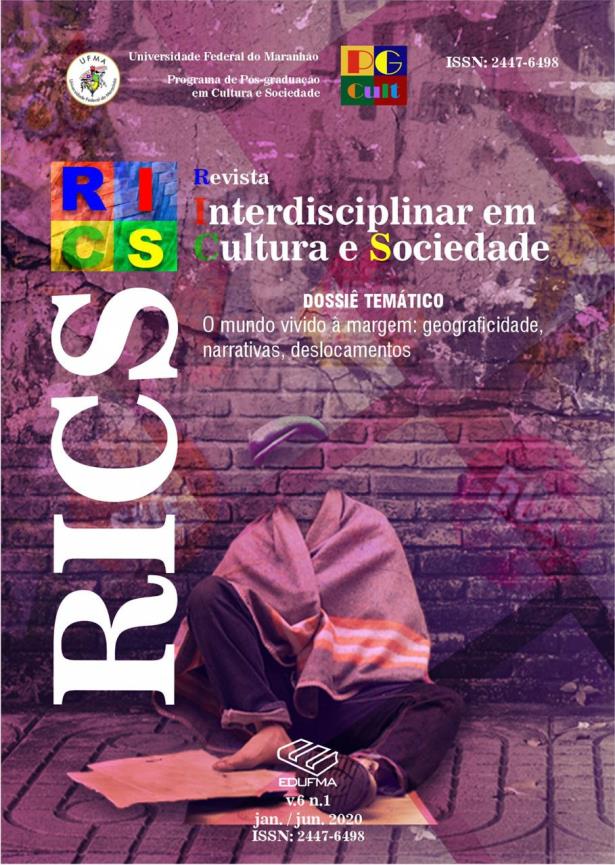Filho da Rua: um Olhar sobre o Marginalizado no Conto “Di Lixão”, de Conceição Evaristo
DOI:
https://doi.org/10.18764/2447-6498.v6n1p125-138Palavras-chave:
Espaço-Lugar. Deslocamento social. “Di Lixão”. Conceição Evaristo.Resumo
O seguinte trabalho trata de uma análise acerca da experiência do marginalizado – menino de rua – e a sua relação com o espaço e o outro em seu contexto de deslocamento, retratado no conto “Di Lixão”, presente no livro Olhos d’água (2015), da autora afro-brasileira Conceição Evaristo, que, nos meandros de sua escrevivência, encena as anomalias vividas por muitos na periferia da sociedade brasileira, vítimas da desigualdade e exclusão. Este trabalho se preocupará em mostrar as experiências do marginalizado na narrativa de Evaristo - neste caso o menino Di Lixão, quando de seus últimos momentos de vida figurados em uma dolorosa morte, causada por um dente inflamado. Há ainda uma rememoração de experiências dolorosas do passado, protagonizada pela intensa dor que lhe consome a vida, reafirmando, portanto, sua condição de menino de rua marginalizado em uma circunstância de solidão. Para além, suas reminiscências estão sempre ligadas à dor, quer seja física, quer sejam dores da alma, vinculadas principalmente à figura materna, por quem sente ojeriza. Paradoxalmente é percebida sua relação de pertença e afetividade com a rua, isto é, a margem da sociedade, lugar em que se consolida sua relação existencial com a Terra, por conseguinte, sua morte. Esses aspectos serão percebidos à luz da Geografia Humanista Cultural, de base fenomenológica e dos Estudos de Identidade, sobretudo, das identidades subalternas, dando atenção aos sentimentos e sensações que o personagem Di Lixão estabelece com as pessoas, a favela e a rua, atentando-nos às categorias de espaço, lugar e a situação de deslocamento social. Portanto, esta análise utilizará como pressupostos teóricos, principalmente, os apontamentos de autores como Eric Dardel (2015), Yi-Fu Tuan (2012, 2013), Edward Relph (2014), Ana Paula Coutinho (2018), Clarice Cohn (2005).
Palavras-chave: Espaço-Lugar. Deslocamento social. “Di Lixão”. Conceição Evaristo.
Son of the Street: a Look upon the Marginalized in Conceição Evaristo’s Tale “Di Lixão”
ABSTRACT
The following work deals with an analysis about the experience of the marginalized – homeless boy - and its relationship with space and the other in its displacement context, portrayed in the tale “Di Lixão” present in the book Olhos Água (2015) Afro-Brazilian author Conceição Evaristo, who in the intricacies of her writing writes the anomalies experienced by many in the periphery of Brazilian society, victims of inequality and exclusion. This paper will focus on showing the experiences of the marginalized in Evaristo's narrative - in this case the boy Di Lixão, when in his last moments of life figured in a painful death caused by an inflamed tooth. There is still a recollection of painful experiences of the past led by the intense pain that consumes his life, thus reaffirming his condition as a street kid marginalized in a circumstance of loneliness, besides, his reminiscences are always linked to pain, whether physical or physical. whether they are pains of the soul, linked mainly to the maternal figure, by who feels antipathy. Paradoxically its relation of belonging and affection with the street is perceived, that is, the margin of the society, place in which its existential relation with the Earth is consolidated, therefore, its death. These aspects will be perceived in the light of the Humanistic Cultural Geography, based on phenomenology and Identity Studies, especially the subaltern identities, paying attention to the feelings and sensations that Di Lixão character establishes with people, the favela and the street, paying attention to the categories of space, place and the situation of social displacement. Therefore, this analysis will use as theoretical assumptions, mainly, the notes of authors such as Eric Dardel (2015), Yi-Fu Tuan (2012, 2013), Edward Relph (2014), Ana Paula Coutinho (2018), Clarice Cohn (2005).
Keywords: Space-Place. Social displacement. “Di Lixão”. Conception Evaristo.
Downloads
Downloads
Publicado
Como Citar
Edição
Seção
Licença

Este trabalho está licenciado com uma Licença Creative Commons Atribuição 4.0 Internacional.


















